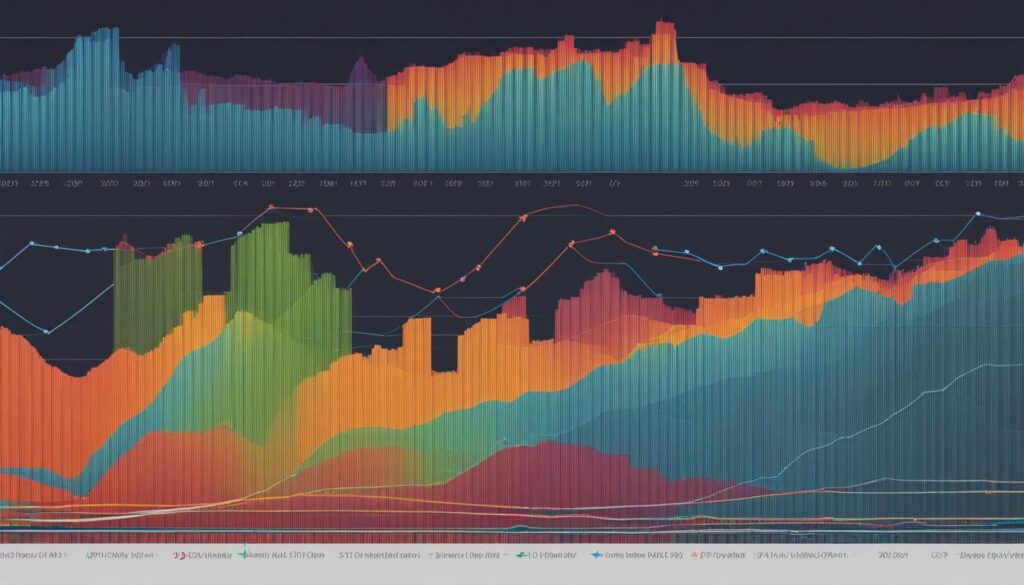When it comes to investing, small-cap stocks offer a unique opportunity for investors seeking high growth potential. These stocks belong to smaller companies with market capitalizations ranging between $300 million to $2 billion. While they may be overshadowed by their larger counterparts, small-cap companies have their own advantages that can lead to substantial returns on investment.
Investing in small-cap stocks allows you to tap into the growth potential of smaller companies. These companies are often in their early stages of development, which means they have room to expand and can adapt quickly to market changes. By investing in smaller companies, you have the chance to discover undervalued stocks with significant growth potential.
Key Takeaways:
- Small-cap stocks belong to smaller companies with market capitalizations between $300 million and $2 billion.
- Investing in small-cap stocks offers the potential for higher growth compared to larger companies.
- Small-cap stocks provide portfolio diversification and the opportunity to invest in undervalued companies.
- Investors should carefully assess the risks associated with small-cap investing, including higher volatility and liquidity risks.
- Analyzing financial metrics can help identify high-growth small-cap companies.
What Are Small-Cap Companies and How Are They Different from Other Types?
Small-cap companies, also known as small-capitalization companies, are companies with a market capitalization typically ranging between $300 million and $2 billion. Market capitalization refers to the total value of a company’s outstanding shares of stock. Small caps are distinguished from large-cap companies, which have a market capitalization of over $10 billion.
Compared to larger companies, small caps offer unique characteristics and opportunities for investors. One of the key differences is their higher growth potential. Small-cap companies are typically in their early stages of development, which means they have more room to expand and capture market share. This growth potential can lead to higher returns for investors.
However, investing in small caps also comes with higher risk. Due to their smaller size, these companies are often more susceptible to market volatility and may experience larger price swings. Additionally, small caps may have less liquidity, making it more difficult to buy or sell shares without impacting the stock price. The lack of analyst coverage compared to larger companies can also make it more challenging for investors to obtain comprehensive information about small-cap stocks.
Table: Comparison of Small-Cap and Large-Cap Companies
| Criteria | Small-Cap Companies | Large-Cap Companies |
|---|---|---|
| Market Capitalization | Between $300 million and $2 billion | Over $10 billion |
| Growth Potential | Higher due to early-stage development | Lower compared to small caps |
| Risk | Higher volatility, liquidity risks | Lower volatility, higher liquidity |
| Analyst Coverage | Less coverage | More coverage |
Despite the risks, investing in small-cap companies can be rewarding for those who are willing to do their research and carefully assess the potential. Small caps provide exposure to emerging trends and innovative industries, allowing investors to be a part of the growth story of these companies. With thorough analysis of financial metrics and proper risk management, investors can identify high-growth small-cap companies that have the potential to deliver significant returns.
The Benefits of Investing in Small-Cap Companies
Investing in small-cap companies can offer several benefits for investors looking to diversify their portfolios and seek high growth potential. Small-cap stocks, with market capitalization ranging between $300 million to $2 billion, present unique opportunities in the market.
One of the primary advantages of investing in small-cap companies is the potential for higher growth compared to larger, more established companies. Small caps are often in their early stages of development, allowing them ample room for expansion and innovation. This growth potential can result in significant returns for investors who identify undervalued small-cap stocks with strong growth prospects.
Another benefit of investing in small-cap companies is portfolio diversification. By including small caps in a portfolio, investors can reduce their exposure to larger, more established companies and sectors. This diversification can help offset the potential risks associated with investing in larger companies and provide opportunities for long-term growth.
| Benefits of Investing in Small-Cap Companies |
|---|
| Higher growth potential compared to larger companies |
| Portfolio diversification |
| Opportunity to invest in undervalued companies |
| Potential for acquisition by larger companies |
Furthermore, small-cap companies often present attractive opportunities for acquisition by larger companies. As small caps grow and demonstrate their potential, they may become attractive targets for acquisition. This potential for acquisition can further enhance the returns for investors in small-cap companies.
It’s important to note that investing in small-cap stocks does come with its share of risks, including higher volatility and liquidity risks. However, for investors willing to conduct thorough research and due diligence, small-cap investing can provide access to undervalued opportunities and the potential for significant returns.
Understanding the Risks of Investing in Small-Cap Companies
Investing in small-cap companies can be a lucrative opportunity, but it also comes with its fair share of risks. It is important for investors to have a clear understanding of these risks to make informed investment decisions. Below, we explore the main risks associated with investing in small-cap companies.
Volatility
Small-cap stocks are known for their higher volatility compared to larger companies. The smaller size of these companies makes them more susceptible to market fluctuations and price swings. Volatility can present opportunities for investors to buy low and sell high, but it also means that investments in small caps can be more unpredictable and carry a higher level of risk.
Liquidity Risk
Another risk inherent to small-cap investing is liquidity risk. Due to their smaller size and lower trading volume, small-cap stocks can be less liquid compared to large-cap stocks. This means that it may be more challenging to buy or sell shares at desired prices, especially during periods of market stress. Investors should consider their liquidity needs and be prepared for potential difficulties in executing trades.
Lack of Coverage
Unlike larger companies that are often covered by multiple analysts, small-cap companies may have limited analyst coverage. This lack of coverage can make it more challenging for investors to obtain comprehensive and reliable information about these companies. It requires investors to conduct thorough research and analysis on their own, which can be time-consuming and may increase the risk of making uninformed investment decisions.
It is crucial for investors to carefully assess these risks and consider their risk tolerance before investing in small-cap stocks. The potential for higher returns comes with greater volatility and liquidity risks. By diversifying their portfolios, staying vigilant, and conducting thorough research, investors can navigate these risks and potentially reap the rewards of investing in small-cap companies.
Factors That Contribute to the Growth Potential of Small-Cap Companies
Small-cap companies possess unique attributes that contribute to their growth potential. These factors, ranging from their agility to their presence in niche markets, make investing in small caps an attractive proposition for investors seeking high growth opportunities.
Agility and Adaptability
One key factor that sets small-cap companies apart is their agility in responding to market changes. With their nimble structures and streamlined decision-making processes, small caps can quickly adapt to shifting trends and capitalize on emerging opportunities. This flexibility allows them to navigate market uncertainties and position themselves for growth.
Presence in Niche Markets
Small-cap companies often operate in niche markets that offer limited competition. This positioning provides them with a competitive advantage and allows them to establish themselves as leaders in their respective industries. By catering to specific customer needs and specialized markets, small caps can capture a loyal customer base and achieve sustained growth.
Innovation and Technological Advancements
Embracing innovation and leveraging technological advancements is another factor that contributes to the growth potential of small-cap companies. With fewer bureaucratic layers and rigid structures, small caps are often at the forefront of disruptive technologies and groundbreaking innovations. This ability to embrace change and harness new technologies positions them for rapid growth and market success.
| Factors | Impact |
|---|---|
| Agility and Adaptability | Enables quick response to market changes and capitalization on emerging opportunities. |
| Presence in Niche Markets | Provides a competitive advantage and establishes leadership in specialized industries. |
| Innovation and Technological Advancements | Positions small caps at the forefront of disruptive technologies and fosters rapid growth. |
In summary, the growth potential of small-cap companies is driven by their agility and adaptability, their presence in niche markets, and their ability to embrace innovation and technological advancements. These factors, combined with their nimble structures and streamlined decision-making processes, give small caps a competitive edge in the market and position them for significant growth.
Analyzing Financial Metrics to Identify High-Growth Small-Cap Companies
When it comes to investing in small-cap companies, analyzing financial metrics is crucial in order to identify high-growth potential. These metrics provide valuable insights into the company’s financial health and can help investors make informed decisions. Here are some key financial metrics to consider:
- Revenue Growth: This metric measures the increase in a company’s sales over a specific period of time. High-growth small-cap companies typically have consistent and significant revenue growth, indicating a strong market presence and demand for their products or services.
- Earnings Growth: Earnings growth is a measure of the company’s profitability and its ability to generate sustainable earnings over time. Companies with high earnings growth often have a competitive advantage in their industry and are well-positioned to capitalize on market opportunities.
- Profitability Ratios: Profitability ratios such as gross profit margin, operating margin, and net profit margin provide insights into the company’s ability to generate profits from its operations. Higher profitability ratios indicate efficient cost management and a strong business model.
- Return on Investment: Return on investment (ROI) is a measure of how effectively the company utilizes its resources to generate profits. A high ROI indicates that the company is generating substantial returns on its investments and efficiently utilizing its capital.
“Analyzing financial metrics is essential when identifying high-growth small-cap companies.”
By carefully examining these financial metrics, investors can gain a better understanding of a company’s growth potential and its ability to deliver strong returns. However, it’s important to note that financial metrics should not be considered in isolation but rather in conjunction with other qualitative and quantitative factors. Conducting thorough research and analysis can help investors uncover hidden gems among small-cap companies and potentially capitalize on their high-growth potential.

| Company | Revenue Growth | Earnings Growth | Profitability Ratio | ROI |
|---|---|---|---|---|
| Company A | 10% | 15% | 20% | 25% |
| Company B | 12% | 18% | 22% | 20% |
| Company C | 8% | 12% | 18% | 15% |
The table above provides a hypothetical example of financial metrics for three small-cap companies. As can be seen, Company B has the highest revenue growth, earnings growth, and profitability ratios, indicating its strong growth potential. However, it’s important to conduct further analysis and consider other factors before making any investment decisions.
In conclusion, analyzing financial metrics is a key step in identifying high-growth small-cap companies. By assessing metrics such as revenue growth, earnings growth, profitability ratios, and ROI, investors can uncover companies with the potential for significant growth and returns. However, it’s essential to conduct thorough research and consider other qualitative and quantitative factors before making investment decisions.
Conclusion
Investing in small-cap stocks provides investors with the opportunity to tap into high growth potential and diversify their portfolios. These smaller companies, with market capitalization ranging between $300 million and $2 billion, offer unique advantages such as agility in adapting to market changes and the chance to invest in undervalued companies.
However, it is important to be aware of the risks associated with small-cap investing. These stocks are known for their higher volatility and liquidity risks, which can lead to greater price swings. Thorough research and analysis of financial metrics, such as revenue growth, earnings growth, profitability ratios, and return on investment, can help investors identify high-growth small-cap companies.
By carefully managing the risks and making informed investment decisions, investors can potentially reap significant returns on their investments in small-cap stocks. It is crucial to strike a balance between the growth potential and the risks involved in order to optimize the risk and reward ratio.
FAQ
What are small-cap companies?
Small-cap companies are defined by their market capitalization, typically between $300 million and $2 billion.
What makes small-cap companies different from other types?
Small-cap companies offer higher growth potential compared to larger companies, as they are in their early stages of development and have more room to expand.
What are the benefits of investing in small-cap companies?
Investing in small-cap companies can provide higher growth potential, portfolio diversification, and the opportunity to invest in undervalued companies.
What are the risks of investing in small-cap companies?
Risks associated with small-cap investing include higher volatility, liquidity risks, and the lack of analyst coverage compared to larger companies.
What factors contribute to the growth potential of small-cap companies?
Small-cap companies benefit from their agility, ability to adapt to market changes, and their presence in niche markets, which provides them with a competitive advantage.
How can I identify high-growth small-cap companies?
Analyzing financial metrics such as revenue growth, earnings growth, profitability ratios, and return on investment can help identify high-growth small-cap companies.
How Can I Identify Growth Stocks with High Potential for Capital Appreciation?
When it comes to identifying high-potential growth stocks with a chance for capital appreciation, thorough research is key. Look for companies with a history of consistent revenue and earnings growth, strong market position, and innovative products or services. Additionally, assess their management team, competitive advantage, and industry trends. Analyzing these factors can help you pinpoint identifying high-potential growth stocks with potential for significant capital appreciation.


Pingback: Venture Capital: Fueling High Growth Startups and Businesses – Straight Fire Money